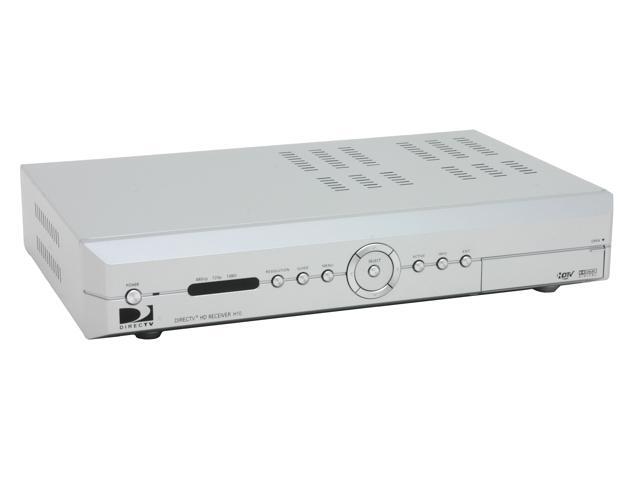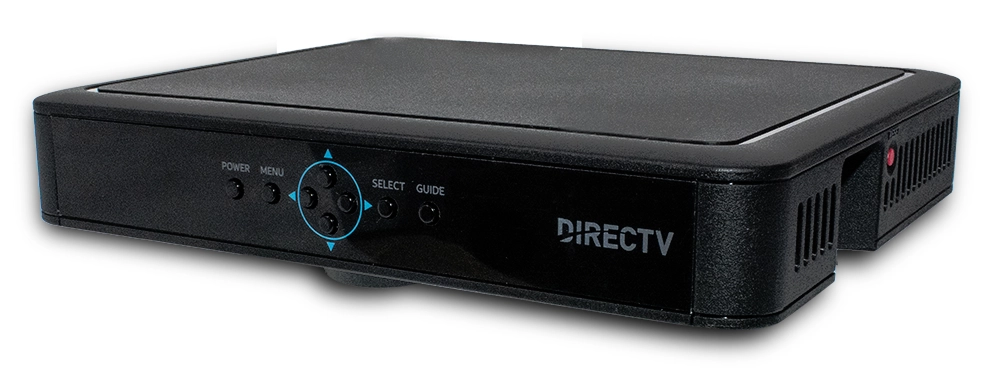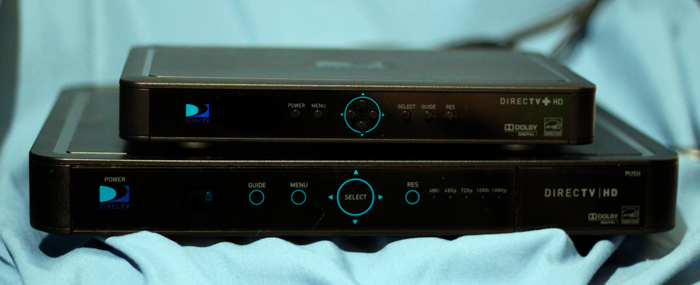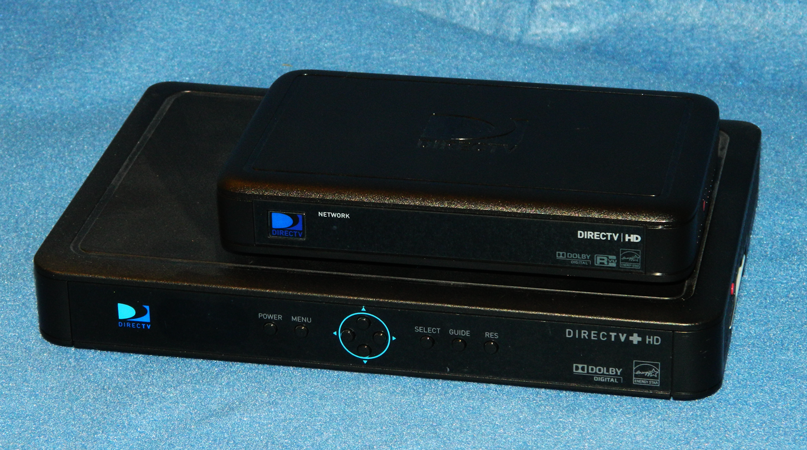There are three HD receivers available at Solid Signal right now: The H24, H25, and H26K. It seems rather odd that you would have a choice, so let’s take a look at the pros and cons of both. First, let’s take a trip down memory lane. There were plenty of receivers before the H24, although most of them won’t work with today’s DIRECTV systems.
DIRECTV was on the forefront of the HD revolution, way back when. Before there was even anything to watch in HD, DIRECTV had a receiver for it. Check out the now-legendary Sony SAT-HD300:

This monstrous beast was the height of 2003 technology. It was bigger than any DIRECTV product made today, but its sleek silver exterior made it stand out no matter what you had. I recall it costing about $1,000. There wasn’t any HD content on satellite back then but if you were one of the roughly 6 people who could get HD broadcasts over the air in 2003, it was just what you needed.
If you had a boat back in the 2000s, you might have had a receiver like this one:

The KVH M10 couldn’t receive HD broadcasts, but I’ve included it in this article as one that should be replaced if possible. It was a receiver that was integrated with an antenna control unit. That sounded like a good idea at the time but when the receiver part stopped working, you couldn’t just replace id.
The next DIRECTV HD receiver came and went quickly. Feast your eyes on the pride of 2005, the H10 receiver from DIRECTV:

This receiver wasn’t on the market long. It was the first receiver that actually got satellite HD broadcasts but within a year, DIRECTV had decided that it would use MPEG-4 technology, not MPEG-2 technology, for its HD broadcasts. This MPEG-2 only beast couldn’t handle that, so H10s came and went really fast.
Unfortunately the next model wasn’t really destined to live a long life either. This is the H20 from DIRECTV, which rolled out in 2006:

It was about the same size as an H10, but it had the all-important capability to receive MPEG-4 broadcasts. Unfortunately even though it had all those massive cooling slots, it had a tendency to overheat and stop working. These were retired within a year of coming out.

This handsome beast is the DIRECTV H21 receiver, also known as “the one that got it right.” Although the pictures are different sizes — blame the internet for not having great photos back then — this receiver was about the same size as the H20, or in today’s world just a little bigger than an HR24. It ran much cooler and was much more reliable than the H20. The H21 and its identical-looking sibling H23 ruled the roost for three years as DIRECTV expanded its HD selection. And then, it was time for H24.

This is the DIRECTV H24 HD receiver. When it was released in 2010, it was a revelation. It features a touchscreen front and a full set of outputs on the back, including component, composite, and HDMI. It also has an ethernet port and can be used with older, non-SWM DIRECTV systems.

This is the DIRECTV H25 receiver. It doesn’t have a touchscreen on the front, doesn’t have component outputs, and doesn’t have a ethernet port. It must be used with a SWM system and will not work with the older systems. Although the picture doesn’t show it, it’s about half the size of the H24.

The DIRECTV H26K Commercial receiver is just slightly smaller than the H25. Like the H25 it must be used with a SWM system. It supports 4K and is only available for commercial customers.
It’s hard to see in the photos above but these receivers are much smaller than the ones that came before. This is the H25 sitting on an H21:

and here’s the H25 at top with H24 at bottom:

Finally here is a Genie Mini Client sitting on top of an H25. These three pictures ought to give you an idea of the relative sizes.

This would seem like a no-brainer, right? Choose the one with more outputs, more inputs, and more abilities, right? After all they are the same price. There’s a little more to the story here.
Let’s get down to it. You might be thinking that the H24 is the better receiver, but that really isn’t true.
The H25 runs a bit faster than the H24, and that speed increase isn’t much but it could make a difference if you watch a lot. The H26K blows both receivers out of the water in terms of speed and reliability.
The H25 and H26K features an external power supply and uses about half as much power as the H24. The external power supply may seem annoying but since the power supply is often the first thing to go, it makes sense to keep it outside, where it can be easily replaced. The power savings is significant, too — it could end up saving you $20 over the time you’ll have the receiver.
The H24 is the only receiver of the group to support non-SWM systems and component output. Both of these are important to RV and marine customers who are working with older satellite equipment or simpler designs. As to the matter of the SWM system… all new systems are SWM. You’ll never get a new non-SWM system unless you build it yourself. So if you’re at home it boils down to the fact that you’re losing compatibility with a system that you’ll never use.
On the other hand the H25 and H26K are so light that they stick easily to the back of a TV with some industrial velcro. So small, in fact, that they fit in the gap in your wall mount. Because the power supply is outside the box, they run more reliably.
Nearly all the H24s and H25s you will find today will be refurbished models made before 2013. H24s were made only in 2009 and 2010 so they will be a little older. Most of them are on their third or fourth trip out to customers. H26K receivers are generally brand new because they only started manufacture on them in late 2023.
DIRECTV stopped making H24s and H25s because they’d made all they needed, and with the move over to Genie technology for most residential customers, they got back a steady supply of perfectly good hardware which is expected to perform well in the field for years to come. H26K is here to take up the slack from the older generation as well.
If you really need the features that the H24 brings and you don’t mind the size, that’s fine. If you are trying to match older receivers you already have, the H25 is the right choice. However, I would really recommend the H26K in most cases due to its efficiency and reliability. If you’re ready to upgrade your DIRECTV system, call the experts at Solid Signal! We’re here for you during East Coast business hours at 888-233-7563. If it’s after hours, fill out the form below.
The post UPDATED: Which DIRECTV Receiver should you pick: H24 or H25? appeared first on The Solid Signal Blog.
Continue reading...
2003-2006: Missteps and early steps
DIRECTV was on the forefront of the HD revolution, way back when. Before there was even anything to watch in HD, DIRECTV had a receiver for it. Check out the now-legendary Sony SAT-HD300:

This monstrous beast was the height of 2003 technology. It was bigger than any DIRECTV product made today, but its sleek silver exterior made it stand out no matter what you had. I recall it costing about $1,000. There wasn’t any HD content on satellite back then but if you were one of the roughly 6 people who could get HD broadcasts over the air in 2003, it was just what you needed.
If you had a boat back in the 2000s, you might have had a receiver like this one:

The KVH M10 couldn’t receive HD broadcasts, but I’ve included it in this article as one that should be replaced if possible. It was a receiver that was integrated with an antenna control unit. That sounded like a good idea at the time but when the receiver part stopped working, you couldn’t just replace id.
The next DIRECTV HD receiver came and went quickly. Feast your eyes on the pride of 2005, the H10 receiver from DIRECTV:

This receiver wasn’t on the market long. It was the first receiver that actually got satellite HD broadcasts but within a year, DIRECTV had decided that it would use MPEG-4 technology, not MPEG-2 technology, for its HD broadcasts. This MPEG-2 only beast couldn’t handle that, so H10s came and went really fast.
Unfortunately the next model wasn’t really destined to live a long life either. This is the H20 from DIRECTV, which rolled out in 2006:

It was about the same size as an H10, but it had the all-important capability to receive MPEG-4 broadcasts. Unfortunately even though it had all those massive cooling slots, it had a tendency to overheat and stop working. These were retired within a year of coming out.
2007-2013: Prime Time for HD receivers

This handsome beast is the DIRECTV H21 receiver, also known as “the one that got it right.” Although the pictures are different sizes — blame the internet for not having great photos back then — this receiver was about the same size as the H20, or in today’s world just a little bigger than an HR24. It ran much cooler and was much more reliable than the H20. The H21 and its identical-looking sibling H23 ruled the roost for three years as DIRECTV expanded its HD selection. And then, it was time for H24.

This is the DIRECTV H24 HD receiver. When it was released in 2010, it was a revelation. It features a touchscreen front and a full set of outputs on the back, including component, composite, and HDMI. It also has an ethernet port and can be used with older, non-SWM DIRECTV systems.

This is the DIRECTV H25 receiver. It doesn’t have a touchscreen on the front, doesn’t have component outputs, and doesn’t have a ethernet port. It must be used with a SWM system and will not work with the older systems. Although the picture doesn’t show it, it’s about half the size of the H24.

The DIRECTV H26K Commercial receiver is just slightly smaller than the H25. Like the H25 it must be used with a SWM system. It supports 4K and is only available for commercial customers.
It’s hard to see in the photos above but these receivers are much smaller than the ones that came before. This is the H25 sitting on an H21:

and here’s the H25 at top with H24 at bottom:

Finally here is a Genie Mini Client sitting on top of an H25. These three pictures ought to give you an idea of the relative sizes.

This would seem like a no-brainer, right? Choose the one with more outputs, more inputs, and more abilities, right? After all they are the same price. There’s a little more to the story here.
Comparing the receivers
Let’s get down to it. You might be thinking that the H24 is the better receiver, but that really isn’t true.
The H25 runs a bit faster than the H24, and that speed increase isn’t much but it could make a difference if you watch a lot. The H26K blows both receivers out of the water in terms of speed and reliability.
The H25 and H26K features an external power supply and uses about half as much power as the H24. The external power supply may seem annoying but since the power supply is often the first thing to go, it makes sense to keep it outside, where it can be easily replaced. The power savings is significant, too — it could end up saving you $20 over the time you’ll have the receiver.
The H24 is the only receiver of the group to support non-SWM systems and component output. Both of these are important to RV and marine customers who are working with older satellite equipment or simpler designs. As to the matter of the SWM system… all new systems are SWM. You’ll never get a new non-SWM system unless you build it yourself. So if you’re at home it boils down to the fact that you’re losing compatibility with a system that you’ll never use.
On the other hand the H25 and H26K are so light that they stick easily to the back of a TV with some industrial velcro. So small, in fact, that they fit in the gap in your wall mount. Because the power supply is outside the box, they run more reliably.
New vs. refurbished
Nearly all the H24s and H25s you will find today will be refurbished models made before 2013. H24s were made only in 2009 and 2010 so they will be a little older. Most of them are on their third or fourth trip out to customers. H26K receivers are generally brand new because they only started manufacture on them in late 2023.
DIRECTV stopped making H24s and H25s because they’d made all they needed, and with the move over to Genie technology for most residential customers, they got back a steady supply of perfectly good hardware which is expected to perform well in the field for years to come. H26K is here to take up the slack from the older generation as well.
Here’s another way of looking at it.
| H24 | H25 | H26K | |
|---|---|---|---|
| Works with all of today’s DIRECTV systems | Yes | Yes | Yes |
| Works with DIRECTV systems made before 2009 | Yes | No | No |
| Outputs SD and HD on multiple outputs | Yes | Yes* | Yes* |
| RF-compatible remote | Yes | Yes | Yes |
| Available for residential accounts | Yes | No | No |
| Shares programming with DVRs (residential accounts only) | Yes | N/A | N/A |
| Energy Star rated | No | Yes | Yes |
| Most reliable design | No | Yes | Yes |
| Smallest design | No | No | Yes |
*H25 and H26K require cable sold separately for multiple outputs
If you really need the features that the H24 brings and you don’t mind the size, that’s fine. If you are trying to match older receivers you already have, the H25 is the right choice. However, I would really recommend the H26K in most cases due to its efficiency and reliability. If you’re ready to upgrade your DIRECTV system, call the experts at Solid Signal! We’re here for you during East Coast business hours at 888-233-7563. If it’s after hours, fill out the form below.
The post UPDATED: Which DIRECTV Receiver should you pick: H24 or H25? appeared first on The Solid Signal Blog.
Continue reading...

